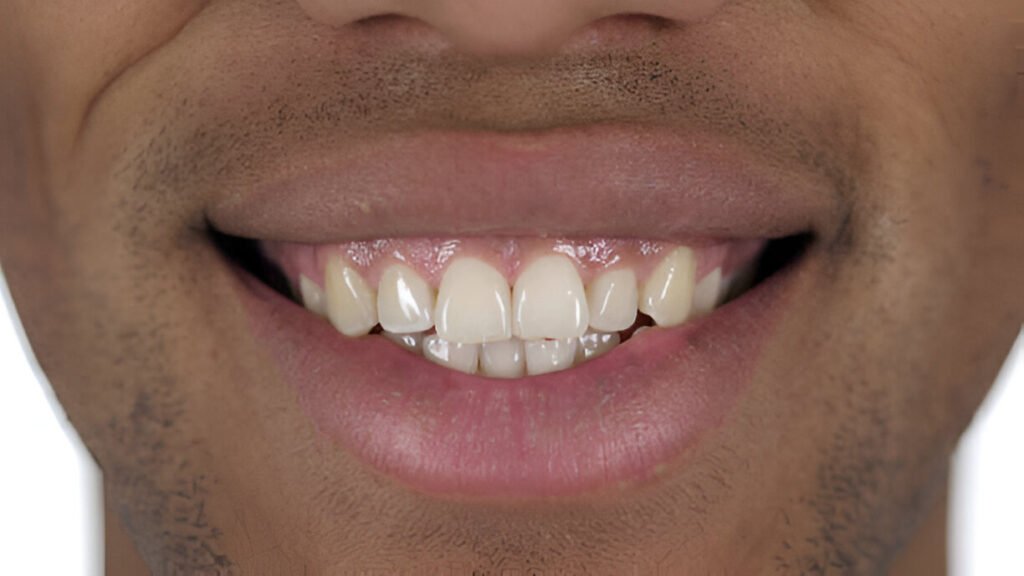Composite bonding is a popular cosmetic dental treatment used to improve the appearance of teeth. While this treatment is known for its natural look, stains can develop over time, which may affect the overall appearance. In this article, we will explore how to get rid of stains on composite bonding, using simple and effective methods that can help restore your smile.
What is Composite Bonding?
Composite bonding is a procedure in which a tooth-coloured resin material is applied to the surface of a tooth to correct imperfections like chips, cracks, and gaps. This treatment is popular because it can be completed in a single visit to the dentist and requires little to no removal of the tooth enamel.
Can You Eat Chips with Bonded Teeth?
Causes of Stains on Composite Bonding
Stains on composite bonding can occur for various reasons. Some of the most common causes include:
- Food and Drinks: Coffee, tea, red wine, and curries can stain composite bonding over time.
- Tobacco Use: Smoking or using tobacco products can leave stubborn stains on composite bonding.
- Poor Oral Hygiene: Not brushing and flossing regularly can cause plaque and tartar build-up on composite bonding, leading to discolouration.
- Age: As composite bonding material ages, it can become more porous and susceptible to staining.
How to Prevent Stains on Composite Bonding
While you cannot prevent staining entirely, there are several things you can do to keep your composite bonding looking fresh for as long as possible:
- Avoid Staining Foods and Drinks: If possible, try to reduce your intake of foods and drinks that cause staining, such as coffee, tea, and red wine.
- Quit Smoking: Tobacco can leave stubborn stains on your composite bonding, so quitting smoking can help maintain its appearance.
- Brush Regularly: Brush your teeth at least twice a day with a soft-bristled toothbrush and a fluoride toothpaste to remove plaque and food particles.
- Floss Daily: Flossing helps to remove plaque and food particles from between your teeth and bonding, preventing stains from forming in these hard-to-reach areas.
- Visit Your Dentist Regularly: Regular dental checkups are important for maintaining the appearance of your composite bonding. Your dentist can clean the bonding and ensure it is still in good condition.
Can You Bite into an Apple with Composite Bonding?
How to Remove Stains from Composite Bonding
If stains have already formed on your composite bonding, don’t worry. There are several methods you can use to remove them and restore your smile.
1. Professional Cleaning at the Dentist
The best way to remove stains from composite bonding is by visiting your dentist for a professional cleaning. During a routine check-up, your dentist will use special tools to remove plaque, tartar, and stains that may have built up on the surface of your bonding. A professional cleaning is safe and effective and can help restore your composite bonding to its natural appearance.
2. Regular Brushing and Flossing
While professional cleaning is the most effective way to remove deep stains, you can keep your composite bonding in good condition by brushing and flossing regularly. Use a non-abrasive toothpaste, as abrasive pastes can scratch the bonding surface, making it more likely to collect stains in the future. Brush your teeth in small, circular motions to gently clean the bonding material without damaging it.
3. Baking Soda and Water
If you prefer a more natural solution, baking soda can be an effective way to remove surface stains from composite bonding. To use this method, simply mix a small amount of baking soda with water to form a paste. Using a soft toothbrush, gently scrub the bonding material with the paste in small circular motions. Be careful not to scrub too hard, as this could damage the bonding surface. After brushing, rinse your mouth with water to remove any excess paste.
How Long Does Composite Bonding Usually Last?
4. Whitening Toothpaste
While whitening toothpaste is not as effective as professional treatments, it can help to remove surface stains on composite bonding. Look for a whitening toothpaste that is non-abrasive and safe for sensitive teeth. Brush your teeth gently using a small amount of whitening toothpaste, focusing on the areas where staining is most noticeable. Keep in mind that whitening toothpaste may not work on all types of stains, especially those that have penetrated the bonding material.
5. Hydrogen Peroxide
Hydrogen peroxide is a mild bleaching agent that can help remove stains from composite bonding. However, it should be used with caution. Dilute the hydrogen peroxide with an equal amount of water, and use a soft toothbrush to apply it to the bonding material. Gently scrub in circular motions to lift the stains. Afterwards, rinse your mouth thoroughly with water. It’s essential not to overuse hydrogen peroxide, as it can cause damage to the bonding material if used excessively.
6. Avoid Harsh Abrasives
Avoid using harsh abrasives like gritty toothpaste, scrubbing pads, or abrasive cleaners to clean composite bonding. These can scratch the surface of the bonding material, making it more susceptible to staining in the future. Always opt for a gentle, non-abrasive toothpaste to preserve the appearance of your bonding.
When to Replace Composite Bonding
If stains on your composite bonding are persistent and cannot be removed with cleaning methods, it may be time to visit your dentist for an evaluation. In some cases, the bonding material may have deteriorated or become too stained to restore effectively. Your dentist may recommend replacing the bonding to restore the natural appearance of your teeth.
Aberdeen Composite Bonding 101: What Is It and How Does It Work?
Conclusion
Composite bonding is an excellent solution for improving the appearance of teeth, but like any dental procedure, it requires regular care to maintain its beauty. By following proper oral hygiene practices and visiting your dentist regularly, you can keep your composite bonding looking fresh and vibrant. If stains do occur, there are several methods you can use to remove them, including professional cleaning, brushing with non-abrasive toothpaste, and using natural remedies like baking soda. For those seeking long-lasting results, Composite Bonding Treatment Aberdeen offers expert care to help maintain a bright, stain-free smile. Remember, prevention is always better than a cure, so take steps now to protect your composite bonding from stains in the future.
Book your consultation today!
Restore Your Smile at Bridge St Aesthetic and Dental Implant Clinic
If you’re struggling with stains on your composite bonding or want to learn more about how to maintain the beauty of your smile, Bridge St Aesthetic and Dental Implant Clinic is here to help. Our team of skilled professionals offers personalised treatments to restore and enhance the appearance of your teeth.
Whether you need a professional cleaning, whitening options, or a consultation for replacing old composite bonding, we have the expertise to help you achieve a radiant smile. Contact us today to schedule your appointment and take the first step toward a healthier, brighter smile!
📞 Call us now at 01224 588477 or visit our website to book your consultation. Let us help you get the smile you deserve!
FAQs About Stains on Composite Bonding
1. Can composite bonding become stained over time?
Yes, composite bonding can stain due to food, drinks, smoking, or poor oral hygiene. Regular brushing and professional cleanings can help maintain its appearance.
2. How long does composite bonding last before it needs replacing?
Composite bonding can last between 5 to 10 years with proper care. However, it may need to be replaced if it becomes too stained or damaged.
3. Are there any foods that should be avoided to prevent stains on composite bonding?
To prevent staining, avoid foods and drinks like coffee, tea, red wine, and curries. Smoking and using tobacco products can also cause discolouration.
4. Can I whiten composite bonding at home?
You can use whitening toothpaste or baking soda for mild stains. However, for deeper stains, it’s best to visit your dentist for professional cleaning.
5. How can I prevent stains from forming on my composite bonding?
Good oral hygiene, such as brushing and flossing regularly, combined with professional cleanings, can help prevent stains and keep your composite bonding looking its best.





